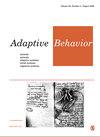Functional relation between postural sway and saccadic eye movements is strong and not altered by moving visual environment and concomitant memory task
IF 1.3
4区 计算机科学
Q4 COMPUTER SCIENCE, ARTIFICIAL INTELLIGENCE
引用次数: 0
Abstract
We investigated whether the adaptation of postural control to perform saccadic tasks is still maintained in challenging situations such as when the posture is challenged with a large movement of the moving room and with the addition of a second perturbation as a visual task of memorization. Thirty young adults (20.0 ± 1.3 years) were randomly assigned to the control and experimental groups. Participants stood upright on a force plate inside a moving room wearing eye-tracking. The room moved back and forth (anterior–posterior direction), at low (.6 cm—first and third trials) and high (3.5 cm—second trial) amplitude, and frequency of .2 Hz. In each trial, participants performed left-right horizontal saccades on a target (1.1 Hz). The experimental group also performed a concomitant number memorization task. There were no differences between groups in the coupling between center of pressure (CoP) displacements and visual stimulus in any condition. There was also no difference in the performance of the saccadic task. In the memorization task, CoP displacements in response to the visual stimulus frequency (room motion) were not affected. The performance in the memorization task was similar between room conditions. Overall, increasing cognitive involvement by adding a working memory task does not deteriorate the postural stabilization of young adults to accomplish accurate gaze shifts. Also, it does not interfere with adaptive visual reweighting due to changes in the moving room amplitude. In conclusion, young adults are flexible in optimizing their postural control to succeed in multiple tasks even under perturbation.体位摇摆与跳眼运动的功能关系较强,且不受运动视觉环境和伴随的记忆任务的影响
我们研究了在具有挑战性的情况下,例如当姿势受到移动房间的大运动的挑战以及作为视觉记忆任务的第二次扰动时,是否仍然保持姿势控制对执行跳跃性任务的适应性。30名年龄(20.0±1.3岁)的青壮年随机分为对照组和试验组。在一个移动的房间里,参与者站在一个测力板上,并戴上眼球追踪仪。房间前后移动(前后方向),在低(低)。6厘米(第一次和第三次试验)和高(3.5厘米-第二次试验)幅度,频率为0.2赫兹。在每个试验中,参与者对目标进行左右水平扫视(1.1 Hz)。实验组还进行了伴随的数字记忆任务。在任何情况下,压力中心位移与视觉刺激的耦合在各组间均无差异。在跳眼任务的表现上也没有差异。在记忆任务中,视刺激频率(房间运动)对CoP位移的响应不受影响。在不同的房间条件下,记忆任务的表现是相似的。总的来说,通过增加工作记忆任务来增加认知参与并不会降低年轻人完成准确凝视转换的姿势稳定性。此外,它不会干扰由于移动房间振幅变化而产生的自适应视觉重加权。综上所述,年轻人可以灵活地优化他们的姿势控制,即使在扰动下也能成功地完成多项任务。
本文章由计算机程序翻译,如有差异,请以英文原文为准。
求助全文
约1分钟内获得全文
求助全文
来源期刊

Adaptive Behavior
工程技术-计算机:人工智能
CiteScore
4.30
自引率
18.80%
发文量
34
审稿时长
>12 weeks
期刊介绍:
_Adaptive Behavior_ publishes articles on adaptive behaviour in living organisms and autonomous artificial systems. The official journal of the _International Society of Adaptive Behavior_, _Adaptive Behavior_, addresses topics such as perception and motor control, embodied cognition, learning and evolution, neural mechanisms, artificial intelligence, behavioral sequences, motivation and emotion, characterization of environments, decision making, collective and social behavior, navigation, foraging, communication and signalling.
Print ISSN: 1059-7123
 求助内容:
求助内容: 应助结果提醒方式:
应助结果提醒方式:


